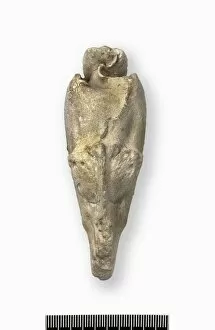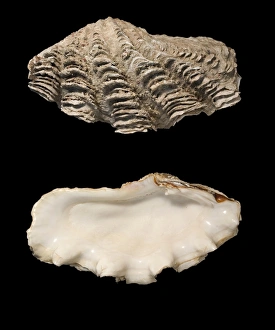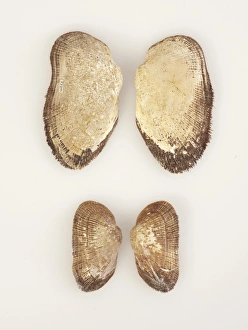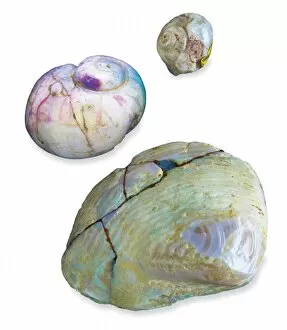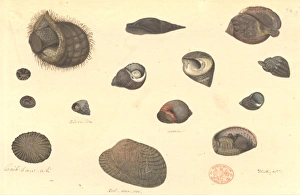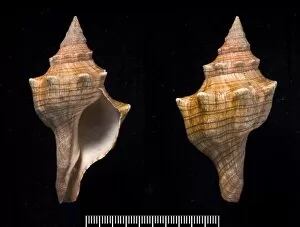Bivalves Collection (page 7)
Bivalves are a type of mollusk animal that have two shells, or valves
510 items
All Professionally Made to Order for Quick Shipping
-
Bivalves Collection
Bivalves are a type of mollusk animal that have two shells, or valves, connected by a hinge and can be found in both marine and freshwater habitats around the world and can filter feeders, meaning they use their gills to strain food particles from the water. They also have an organ called a foot which helps them move around and burrow into the sediment, and are range in size from microscopic to over one meter long. Some species of bivalve produce pearls when irritated by foreign objects such as sand grains or parasites. These animals play an important role in aquatic ecosystems as they help to clean the water and provide food for other creatures like fish and birds.
+
Our beautiful pictures are available as Framed Prints, Photos, Wall Art and Photo Gifts
The Bivalves collection from Media Storehouse features a wide range of stunning wall art and framed prints showcasing the unique beauty of mollusk animals. These creatures belong to the phylum Mollusca, which includes over 100,000 species worldwide. The bivalve group is characterized by their two-part hinged shell, which opens and closes to protect their soft body inside. Our collection includes high-quality images of various types of bivalves such as clams, oysters, mussels, scallops and more. Each print captures the intricate details and vibrant colors that make these creatures so fascinating. Whether you are looking for a statement piece for your home or office or simply want to add some natural beauty to your space, our collection has something for everyone. With its vast selection of bivalve-themed artwork in different sizes and styles available at affordable prices, Media Storehouse makes it easy for anyone to bring the wonders of marine life into their homes.
+
What are Bivalves (Mollusks Animals) art prints?
Bivalves are a group of mollusk animals that have two shells hinged together, such as clams, oysters, and mussels. Bivalve art prints showcase the beauty and diversity of these creatures in stunning detail. These prints can be found on our website, where we offer a wide range of high-quality images featuring bivalves in their natural habitats. These art prints are perfect for those who appreciate marine life or want to add a touch of nature to their home decor. They come in various sizes and formats, including canvas prints, framed prints, and photographic prints. Each print is produced using state-of-the-art printing technology to ensure vibrant colors and sharp details. Whether you're looking for an eye-catching centerpiece or a subtle accent piece for your living space, bivalve art prints from Media Storehouse are sure to impress. With so many options available at affordable prices, it's easy to find the perfect print that suits your style and budget.
+
What Bivalves (Mollusks Animals) art prints can I buy from Media Storehouse?
We offer a wide range of bivalve art prints that are perfect for any nature lover or marine enthusiast. You can choose from various species, including clams, oysters, mussels, and scallops. These stunning prints showcase the intricate details of these mollusk animals in their natural habitats. Whether you prefer black and white photography or colorful illustrations, we have something to suit your taste. The collection includes vintage illustrations from old scientific journals as well as modern photographs taken by talented photographers around the world. These bivalve art prints are available in different sizes and formats such as canvas prints, framed prints, and poster prints. They make great additions to any home decor or office space and also make excellent gifts for friends and family who appreciate marine life. If you're looking for high-quality bivalve art prints that capture the beauty of these fascinating creatures, Media Storehouse is an excellent place to start your search.
+
How do I buy Bivalves (Mollusks Animals) art prints?
To buy Bivalves art prints from Media Storehouse, you can browse our extensive collection of high-quality images featuring these fascinating creatures. Once you have found the perfect print, simply add it to your cart and proceed to checkout. You will be prompted to enter your shipping and billing information, as well as any applicable discount codes or gift cards. We offer a variety of payment options, including credit card and PayPal. We also offer international shipping for customers outside of the UK. Their Bivalves art prints are available in a range of sizes and formats, including framed prints, canvas prints, and photographic prints. Each print is produced using state-of-the-art printing technology to ensure vibrant colors and sharp details. Whether you are looking for a stunning piece of wall art for your home or office or searching for the perfect gift for a nature lover in your life, we have an incredible selection of Bivalves art prints that are sure to impress.
+
How much do Bivalves (Mollusks Animals) art prints cost?
We offer a wide range of Bivalves art prints at varying prices. Our collection includes high-quality prints that are perfect for adding a touch of nature to your home or office decor. The cost of our Bivalves art prints depends on the size and type of print you choose. We have options ranging from small framed prints to large canvas prints, so there is something for every budget and preference. Our Bivalves art prints are created using state-of-the-art printing technology and premium materials, ensuring that each piece is vibrant, detailed, and long-lasting. Whether you're looking for a beautiful addition to your personal collection or a thoughtful gift for someone special, our selection of Bivalves art prints has something for everyone.
+
How will my Bivalves (Mollusks Animals) art prints be delivered to me?
We take great care in ensuring that your Bivalves art prints are delivered to you safely and securely. We use high-quality packaging materials to protect your artwork during transit, so it arrives at your doorstep in pristine condition. Your Bivalves art prints will be carefully rolled and packaged in a sturdy cardboard tube for delivery. This ensures that the print is protected from any damage or creases during transportation. We work with trusted courier partners who offer reliable and efficient delivery services. Once your order has been dispatched, you will receive a tracking number via email, which allows you to track the progress of your shipment online. We pride ourselves on our commitment to customer satisfaction. If for any reason you are not completely satisfied with your purchase, please do not hesitate to contact us and we will do everything possible to resolve any issues promptly.






